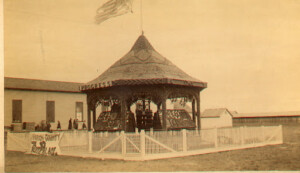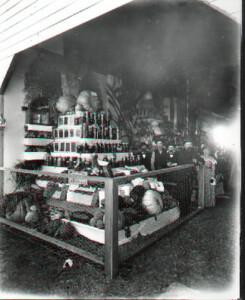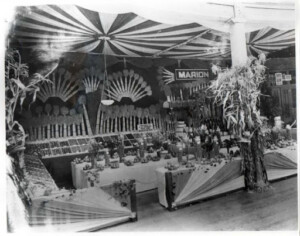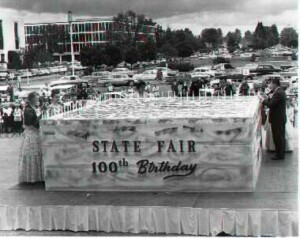Oregon State Fair
“In 2003 , the fairgrounds comprise a total of 185 acres, with 15 permanent buildings. An annual average of 400,000 people from around the state and country enjoy the fair every year, consuming 250,000 hamburgers, 833,333 hot dogs (78.9 miles of hot dogs, if laid end to end), and 40,000 gallons of soda pop. During its 12-day run each year, the fair actually becomes the fifth largest city in the state, complete with its own police, emergency medical services, and public works department. “
Although the Oregon State Fair has long been considered the annual summer-time event in Salem, the fair actually had its modest beginnings at Oregon City in the year 1861. Oregon had not achieved Statehood when, in 1858, The Oregon Farmer began agitating in favor of a State Fair. Two groups, the Oregon State Agricultural Society and the Oregon Fruit Growers Association, eventually merged and took on the task of creating an Oregon State Fair. Through their efforts, the first fair opened near Oregon City on the banks of the Clackamas River, in early October, 1861.
The State Legislature offered no financial support, but the four-day event boasted 142 exhibitors in nine classes, including sheep, swine, poultry, plowing implements and machinery, and domestic manufacturers. There were vegetable and fruit exhibits and equestrian competitions as well, and 268 premiums were awarded. This first fair was essentially a harvest festival, and attendees enjoyed visiting, dancing, and horse racing. Some local ministers urged a boycott because of the horse racing, but this seems not to have affected attendance. With the young state still largely unsettled, the fair offered a rare opportunity for farmers to visit and share information.
Though that first State Fair was not, financially speaking, a resounding success–it broke even–enthusiasm was strong, and organizers immediately decided to hold a second fair the following year. They also realized that a larger site was needed.
The Fair Comes To Salem
On September 18, 1862, Marion County was chosen as the site for the second State Fair, in part because of its closer proximity to the agricultural center of the Willamette Valley. A parcel of eight acres, three miles outside the city of Salem, was donated by John Savage, who had homesteaded the property. John Minto contributed $1,200 to build a wooden fence around the grounds. New events were added, including canning, quilting, and baking and, once again, response was positive.
In 1863, the Fairgrounds were expanded with the purchase of 80 additional acres from David and Margaret Ridout. In 1864, the Oregon Agricultural Society purchased the Fairgrounds and agreed to hold the fair at that location for the next 15 years. Five-and-a-half additional acres were added in 1865, and 70-1/2 more in 1870.
The fair grew steadily during its early years, as new exhibits and attractions were added. In 1877, fairgoers were invited to see two of the latest inventions, Thomas Edison’s gramophone and Alexander Graham Bell’s telephone.
The State Takes Over Fair Operation

1891, The Marion County Fruit Palace at the Oregon State Fair, September 14, 1891., WHC Collections 1998.009.0019
The State of Oregon took over the fair in 1885, when the State Board of Agriculture was formed. It consisted of eight Oregonians, appointed by the Governor, and the four members of the Oregon Agricultural Society. The State Board of Agriculture was required to hold an annual State Fair; given the power to regulate the fair, and required to make an annual report to the Governor. The State Legislature was directed to allocate $5,000 annually for premiums.
Racetrack Added
In 1893, the State spent $11,000 upgrading and renovating the buildings and grounds, including new water and drainage systems, an enlarged floral garden, and the addition of a mile-long racetrack. In 1895, the fair was extended to ten days. William Jennings Bryan visited the fair that year, making a speech about the necessity of buying local products–he himself purchased two Salem-made blankets. By an act of the 1897 Oregon Legislature, the Fairgrounds became property of the State of Oregon.
Admission To The Fair Increased To 26 Cents

1900 c., Marion County Display at Oregon State Fair. Various Vegetables and home canned fruits and vegetables on display. 4 men and 1 woman in background. Salem Public Library MJON 0154, WHC Collections 1998.010.0045
With the new century, the improvements and additions continued. While horse racing and livestock exhibitions were still mainstays of the fair, other events were added: the lumber and dairy industries began to be featured along with the traditional agricultural exhibits. Circuses and band concerts became popular features of the fair. Streetcar service to the fair became available. Twelve new livestock barns were added and, in 1906, admission increased from 25 cents to 26 cents; the fair cleared $20,000 that year.
No fair was held in 1905 due to the big Lewis and Clark Exposition in Portland that year. On display at the 1910 State Fair was another new invention, the airplane, the first many fairgoers had seen. The fair continued through the years of World War I, continuing to operate during those years, and an auto and tractor show was added in 1918.
Automobile Changes The Fair
The years 1920-1940 saw a marked increased in participation from beyond the Willamette Valley, due largely to the ascendance of the automobile. During its early years, many families had camped out for the duration of the fair, with as many as 3,000 people camping in tents and wagons near the grounds. The dawn of the automobile age changed this: faster transportation meant visitors could stay a day or two instead of an entire week, and also that participants could truck in their animals instead of herding them to the fair. The automobile also made possible wider participation from around the state. Where previously, participants had come mostly from the Willamette Valley, now the event became truly a State Fair.
The fair continued to expand, gradually growing from its agricultural beginning to include automobile displays, concerts, and movies. A new boys’ and girls’ club building was added, and a first aid station. The Salem police took over patrolling the grounds when the Fairgrounds were annexed into the City of Salem in 1921. In 1927, the fair began operating on Sundays–although no horse racing was allowed on the Sabbath: it was replaced by sermons and vaudeville acts. In 1929, a new 6,500-seat grandstand was added at a cost of $150,000.
Improvements Continue

Oregon State Fair, Marion County Booth. Shows bundles of wheat bins and plates of fruits, vegetables. Stalks of corn tied to posts. Salem Public Library MJON 0152, WHC Collections 1998.010.0062
With the country in the throes of the Great Depression, admission was reduced from 50 cents to 25 cents in 1933. Parimutual betting was introduced to the fair that year, and opening day was moved back to Labor Day, to take advantage of the holiday. 1934 marked the centennial of Jason Lee’s arrival in Salem, and the fair celebrated with a caravan re-enacting his journey westward. The wagon train left Boston in April and arrived in Salem in time for the fair. The old attendance record was shattered that year, when more than 180,000 visitors flocked to the fair. A 1-1/3 mile racetrack was built, and an Indian Village added, populated by members of the Snohomish Tribe of Washington. In 1939, a 5,000-animal stock barn was built, along with a new goat barn and restaurant. A “seeing eye” was added to the racetrack, in case of photo finishes.
World War II Comes To The Fair
With the country engaged in World War II, the 1942 fair was scaled back to include only 4-H displays, livestock exhibits, and 27 county displays; it was not considered an official State Fair. During 1943 and 1944, operation of the fair was suspended entirely, and the grounds leased to military units as a place to bivouac. In the summer of 1943, at the request of the Willamette Valley Cherry Growers, the Fairgrounds became a labor camp for the Mexican workers needed to harvest the cherry crop.
Sammy Davis Junior Comes To The Fair
With the end of the war, the State Fair was soon in full swing again and, in 1946, Governor Earl Snell’s opening day speech was broadcast over radio for the first time, inaugurating a new tradition at the fair. A moveable stage on a track was created for the musical reviews and variety shows which were held at the grandstand. Sammy Davis, Jr., played this stage as an unknown with his father and brother, as did Ted Mack.
Beer Is Served, But Only For A Short Time!
In 1951, the State Fair was removed from the jurisdiction of the Department of Agriculture and put under the control of the State Fair Commission, newly created by the Legislature. Commission members served four-year terms and were appointed by the Governor. In 1953, the Fair Commission, looking for a reliable source of revenue, approved the sale of beer at the fair. The approval was swiftly rescinded when church groups objected, citing the importance of maintaining a family atmosphere for the fair’s many youthful participants. The fair continued to grow in the 1950s and, by 1957, the fair was clearly outgrowing its space–only 15 counties had room for their displays.
JFK Comes To The Fair

1962, 100th Birthday of Oregon State Fair. Photo taken on front steps of State Capitol Building. State Library building and Labor and Industries building at left. Salem Public Library MJON 0142, WHC Collections 1998.010.0035
In 1960, campaigning for the Presidency, John F. Kennedy made a stop at the fair. The theme of the 1961 fair was the “100th Birthday of the 96th Annual Fair.” A birthday party was held on the Capitol steps, complete with a 16×16-foot cake, portrayals of Oregon’s historical figures, and square dancing. A hit at the fair was the Thor rocket, one of which had earlier that year put a Pioneer satellite into orbit around the sun.
Dates Of Fair Change For School Children
In 1962, KOAC TV, Corvallis, and KOAP TV, Portland, began broadcasting from the Natural Resources Building, covering fair events in addition to its regularly scheduled programming. Fairgoers were invited to stop by and view the broadcasts in progress. In 1964, attendance dropped off sharply when the children returned to school following the Labor Day holiday, prompting the State Fair Commission to reschedule the 1965 fair to run from August 29th through September 6th, Labor Day. Educators and 4-H leaders applauded the change, which meant participation in the fair would not interfere with school.
While there was concern that the change would mean loss of horseracing revenues, the Labor Day end to the fair has remained to this day. The 1965 fair was considered the true centennial of the fair, and Northwest Natural Gas created a 75-foot candle, the “Oregon Flame,” to honor Oregon agriculture. The candle, fueled by natural gas, was turned on by Governor Mark Hatfield as the fair opened. A brand new Women’s Building was added that year.
Fire At The Fair
In July, 1967, less than a month before the fair was due to open, a major fire hit the Fairgrounds. Two buildings were total losses: the 63,000-square-foot Commercial Building; and the 47,188-square-foot Natural Resources Building, which had been built in 1891. Forty percent of the commercial exhibit space was lost, and Pacific Northwest Bell and Northwest Natural Gas lost permanent exhibits. There were no major injuries, but all Salem firemen were called to the scene. Insurance coverage on the two buildings amounted to only $750,000, while replacement costs were estimated to be $2-3 million.
Fortunately, fair officials had been working with an architect on long-range changes to the Fairgrounds. Those plans were put on display at the 1967 fair, which went on as scheduled, housed in tents donated by church groups, the Portland Rose Festival, and West Coast Carnival, Inc. A patient from the Fair-view Training Center, who had been working in the Commercial Building before the fire, was charged with arson in the fire and pleaded not guilty by reason of insanity.
Synchronized Swimming
Two years after the fire, Governor Tom McCall dedicated the new Agricultural Exhibits and Commercial Hall buildings. The hit of the 1970 State Fair was the 103-foot replica of the rocket that took Gemini into orbit and a display of moon rocks, which had been sent to Governor McCall from President Richard Nixon. An additional charge for daily shows was added to the ticket price in 1971 and, that same year, beer was sold for the first time. In 1972, a tribute to the timber industry featured two acres of exhibits, including a 32-foot high model of Mt. Hood, complete with glacial cold air, trees, fish pond, and creek.
In 1974, Lillie Ward became State Fair Director, the first woman to hold the position–and the next year, the Women’s Building, in keeping with the times, was renamed the Living Arts Building. The centerpiece of 1975’s “Salute to the Sea” was the 175,000-gallon “Oregon Ocean,” a huge pool used for synchronized swimming shows and water polo matches. The carnival was enlarged in 1976, and the grounds received a general facelift in 1978.
Rufus The Wayward Steer
One of the more amusing incidents in fair history occurred on opening day, 1979, when a steer named Rufus escaped from his handlers, swam the Willamette River, and found his way to a cornfield, where he stayed for six weeks. Rufus became the fair’s mascot, and was displayed–behind reinforced fencing–from 1980 through 1987. Sadly, Rufus was euthanized in early 1988 after he injured his leg.
But the fair did poorly financially during these years, even though attendance continued to increase and the length of the fair was lengthened. The mission of the fair was debated: should it remain true to its rural, agricultural roots, or should it become more “modern” and urbanized? In 1974, a Legislative Emergency Board subcommittee even recommended a study to determine whether the fair should be abolished. In January, 1975, Governor Robert Straub and more than 200 people jammed a session of the Joint Ways and Means Committee to support continuation of the fair.
At issue was a proposed $1.5 million General Fund expenditure for a multipurpose building and other improvements. The Committee eventually approved the financing, with additional financial support pledged by the City of Salem, Marion County, and the Salem Chamber of Commerce. After numerous delays and a plea to the Emergency Board for additional funds, the Jackman-Long Building was finally dedicated in August, 1976.
Because of the fair’s financial problems, Governor Straub restructured the State Fair Commission and gave control over the fair to the Executive Department, with a fair director to be appointed by the Governor. The State Fair Commission would be expanded to nine members, who would serve the director in an advisory capacity.
Improvements continue
The 1980 fair set a new attendance record, with 647,999 visitors over the fair’s ten-day run. The fair began booking well-known acts for its weekday shows, in an effort to boost weekday receipts. In 1982, a new modern $137,000 “manure removal system” was installed after problems with the City of Salem over the handling of manure at the Fairgrounds. The rodeo, which had suffered from lack of attendance and low revenues, was discontinued in 1983. Three new “trolley” wagons, built by inmates of the Oregon State Penitentiary and pulled by tractors, began shuttling visitors between parking and the Fairgrounds in 1985.
Another attendance record was set in 1986: 791,000, and this was broken the next year, when 818,285 people visited the fair. That year also saw the dedication of a new $2.4 million livestock pavilion, and the 9,000-seat L.B. Day Amphitheater. A second arson fire, this one set by three young girls, erupted in March, 1989, destroying a beef barn and doing a total of $737,690 in damages. A $1 million, 21,000-square-foot beef barn opened in time for the fair in August.
Today
Today, the Fairgrounds comprise a total of 185 acres, with 15 permanent buildings. An annual average of 400,000 people from around the state and country enjoy the fair every year, consuming 250,000 hamburgers, 833,333 hot dogs (78.9 miles of hot dogs, if laid end to end), and 40,000 gallons of soda pop. During its 12-day run each year, the fair actually becomes the fifth largest city in the state, complete with its own police, emergency medical services, and public works department.
The Oregon State Fair has weathered growing pains and financial woes in its history, and has continued to expand and evolve. From a tiny harvest festival on the banks of the Clackamas River, it has grown into a large and diverse event, with something for everyone: livestock, floral, 4-H and home economics exhibits, country western and jazz concerts, commercial exhibits, art and photography displays, food from all cultures and, of course, the carnival. The Oregon State Fair continues today as a true celebration of Oregon.
In October, 2002, the old State Fair Grandstand was demolished, with ornamental work on its stucco façade to be salvaged for the replacement facility. The new facility will be constructed to accommodate concerts. The future on its horse-racing is unknown. In 2004, the new exhibition hall opened to the public replacing the race track.
Written and compiled by Kathleen Clements Carlson
Bibliography:
Branaugh, Barry; and Dayna J. Collins, Susan Gibby, LaVerne Marker, Mark McKinney. “The Oregon State Fair: A History.”
“Historical Context Statement for Salem,” Aug. 1992; Appendix F: pp. 75-76.
Capital Journal, Salem, OR; August 30, 1961.
Interview: Leo Spitzbart by Edwin Culp, Sept. 1969; Marion County Historical Society.
www.OregonStateFair.org
This article originally appeared on the original Salem Online History site and has not been updated since 2006.







Leave A Comment